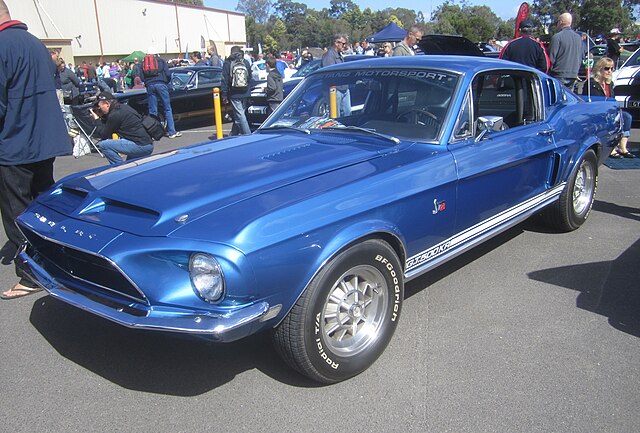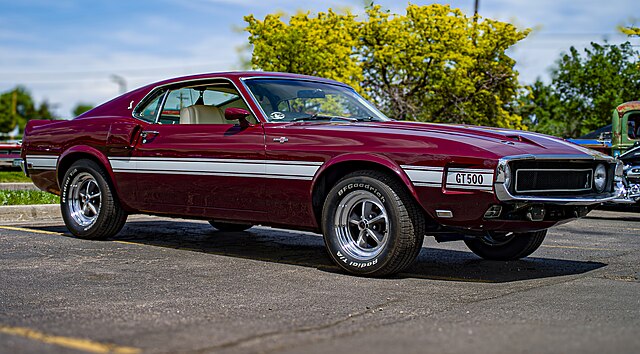
The Shelby Mustang GT500, produced between 1967 and 1970, remains one of the most iconic American muscle cars. With its aggressive design, powerful engine, and association with racing legend Carroll Shelby, the GT500 has etched its name in automotive history.
This article delves into the origins, development, features, and legacy of this remarkable vehicle.
Origins and Development

Carroll Shelby and Ford Partnership
The genesis of the Shelby Mustang GT500 traces back to the partnership between Carroll Shelby and Ford Motor Company. Carroll Shelby, a former race car driver and successful car manufacturer, collaborated with Ford to produce high-performance versions of the Mustang. The first fruit of this collaboration was the GT350 in 1965, followed by the more powerful and luxurious GT500 in 1967.
The Birth of the GT500
Introduced in 1967, the Shelby Mustang GT500 was designed to be more than just a street car. It was envisioned as a performance vehicle that could dominate both the roads and the racetracks. The GT500 was an upgrade from the GT350, featuring a larger engine and more luxurious amenities.
Design and Features

Exterior Design
The Shelby Mustang GT500’s design was a significant departure from the standard Mustang. It featured a longer nose, a distinctive front grille with a Cobra emblem, and functional hood scoops for better airflow. The rear end sported a ducktail spoiler and sequential tail lights, giving it a unique and aggressive look.
Interior Comfort
Inside, the GT500 was a blend of performance and comfort. It came with a deluxe interior package that included special instrumentation, comfortable bucket seats, and a wood-rimmed steering wheel. The dashboard featured Shelby-specific gauges and a prominent tachometer, emphasizing its racing pedigree.
Powertrain and Performance
The heart of the Shelby Mustang GT500 was its powerful engine. The 1967 model came equipped with a 428 cubic inch (7.0L) Police Interceptor V8 engine, producing 355 horsepower. This engine was later upgraded to the 428 Cobra Jet in 1968, delivering even more power and performance.
Suspension and Handling
To handle the increased power, the GT500 featured upgraded suspension components, including heavy-duty springs and shocks. The car’s handling was further enhanced by front disc brakes and power steering, making it more agile and responsive on the road.
Evolution Over the Years

1968 Model Year
The 1968 Shelby Mustang GT500 saw several improvements and changes. The most notable was the introduction of the GT500KR (King of the Road) variant, which featured the more powerful 428 Cobra Jet engine. This engine was rated at 335 horsepower but was known to produce much more, making the GT500KR a formidable performer.
1969–1970 Model Years
In 1969, the Shelby Mustang received a significant redesign. The new model featured a more aerodynamic body with a fiberglass hood, side scoops, and a rear spoiler. The 1969 and 1970 models also offered the option of a 351 cubic inch (5.8L) Windsor V8 engine, providing a balance between performance and affordability.
End of an Era
By 1970, the muscle car era was beginning to wane due to increasing insurance costs and stricter emissions regulations. Ford decided to discontinue the Shelby Mustang line, making the 1970 model the last of the original GT500s. However, the legacy of the GT500 would endure, influencing future generations of Mustangs.
Legacy and Impact

Influence on Future Mustangs
The Shelby Mustang GT500 set a standard for performance and design that future Mustangs would strive to meet. Its combination of power, style, and handling influenced the development of subsequent high-performance Mustangs, including the modern-day GT500s.
Cultural Icon
The GT500 has also made a significant impact on popular culture. It has been featured in numerous movies, TV shows, and video games, cementing its status as an American automotive icon. One of the most famous appearances was in the 2000 film “Gone in 60 Seconds,” where a 1967 Shelby GT500, nicknamed “Eleanor,” played a starring role.
Collector’s Item
Today, the Shelby Mustang GT500 is highly sought after by collectors and enthusiasts. Its rarity, performance, and historical significance make it a valuable addition to any classic car collection. Well-preserved examples of the GT500 can fetch high prices at auctions, reflecting their enduring appeal.
Technical Specifications

Engine Options
- 1967 GT500: 428 cubic inch (7.0L) Police Interceptor V8, 355 horsepower
- 1968 GT500: 428 cubic inch (7.0L) Cobra Jet V8, 335 horsepower (official rating)
- 1969–1970 GT500: 428 cubic inch (7.0L) Cobra Jet V8, 335 horsepower (official rating)
- Optional 351 cubic inch (5.8L) Windsor V8 available in 1969 and 1970
Performance Metrics
- 0-60 mph: Approximately 6.5 seconds (varies by model year and engine)
- Quarter Mile: Approximately 14.5 seconds at 98 mph (varies by model year and engine)
- Top Speed: Around 140 mph
Dimensions
- Wheelbase: 108 inches
- Length: 186.6 inches (1967–1968), 187.4 inches (1969–1970)
- Width: 70.9 inches (1967–1968), 71.3 inches (1969–1970)
- Height: 51.0 inches (1967–1968), 51.6 inches (1969–1970)
Conclusion
The Shelby Mustang GT500 remains a symbol of American muscle car excellence. From its inception in 1967 to its final production year in 1970, the GT500 embodied the spirit of performance and innovation.
Carroll Shelby’s vision, combined with Ford’s engineering prowess, created a car that continues to captivate enthusiasts and collectors alike. As we look back at the GT500’s storied history, it is clear that its legacy will endure for generations to come.
The Shelby Mustang GT500 is not just a car; it is a legend, a testament to a bygone era of automotive passion and ingenuity. Whether on the streets or the silver screen, the GT500’s roar will always be a reminder of what true performance feels like.
